|
RESULTS
New Species Descriptions
Nitzschia taylorii Alakananda, P.B.Hamilton & Karthick, sp. nov. (Figs 1–25)
Valves lanceolate to linear lanceolate with protracted round to capitate apices . Valve mantle wider on keel side
with siliceous nodules present immediately below keel. Length 22–42 µm, width 5–7.5 µm with 21–25 striae in 10 µm and 10–14 fibulae in 10 µm. Keel marginal, rounded, elevated from valve face and mantle (Figs 13,
14). Raphe continuous from apex to apex without central area (Fig. 18) and with terminal apices deflected
towards valve face as continuous loop across apex mantle (Figs 15, 17). Striae uniseriate across valve face,
extending onto keel (Fig. 16). Mantle on opposite side of keel, with 2–3 elongated areolae and a broad hyaline
basal margin (Fig. 18). On keel side, mantle with 2–4 elongated areolae comprising each stria (Figs 20, 21)
with a solid surface at basal margin scattered with small papillae (Fig. 26). Areolae on valve face round to
elongated depressions, not occluded (Fig. 22). Internally, each stria covered by hymen, and fibulae round to
rectangular in shape throughout valve (Figs 23, 25). Cingulum composed of numerous open copulae.
Epicingulum of four bands, all with different surface structure. Valvocopula with single row of large elliptical
pores on pars exterior and a row of small fine papillae along bottom of band (Figs. 20, 26). Second and third
bands with narrow external exposure, with no visible pores, but with fine papillae along bottom of band (Fig. 26). Fourth band broad with a series of narrow elongated pores along pars exterior and a wide area devoid of
structure at base of band (Fig. 21).
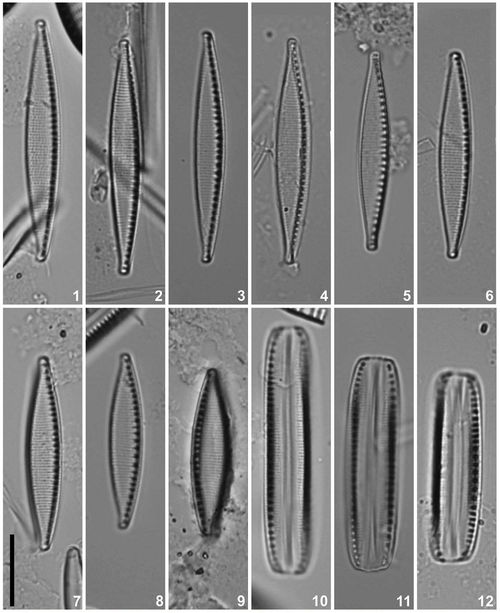
FIGURES 1–12. Light microscopy of Nitzschia taylorii sp. nov. Figs. 1–9. LM of valve view showing the size diminution series. Figs.
10–12: LM of girdle view. Fig. 7 = holotype. Scale bars = 10 µm. (Specimens from holotype slide CESH-5-1881)
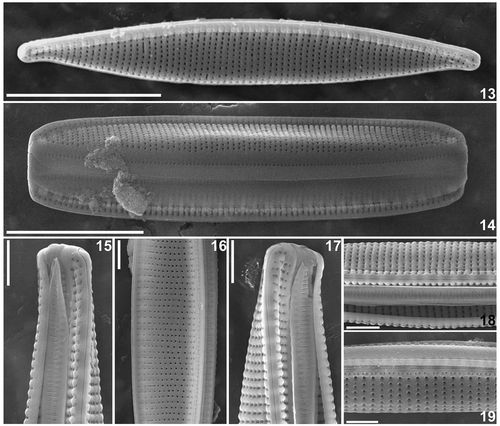
FIGURES 13–19. SEM micrographs of Nitzschia taylorii sp. nov. Fig. 13. SEM of external view of the entire valve. Fig. 14. SEM of
girdle view showing valve bands. Fig. 15. SEM view of valve apex with deflected raphe terminal. Figs 16–17. SEM external view of
raphe, valve mantle and areolae structure. Fig. 18. SEM of external view of central area of N. taylorii showing uninterrupted raphe.
Fig.19. SEM of external view of central area of N. frustulum showing interrupted raphe. Scale bar in Figs 13, 14 = 10 µm; Figs 15–19
= 2 µm. (Specimens from sample CANA 85055)
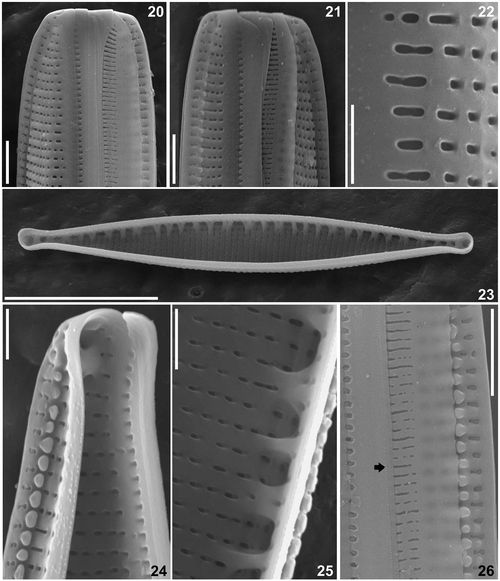
FIGURES 20–26. SEM micrographs of Nitzschia taylorii sp. nov. Figs 20, 21. SEM of external girdle view showing valve bands. Fig.
22. SEM external view of areolae structure. Fig. 23. SEM internal view of entire valve. Fig 24. SEM internal view of valve apices. Fig.
25. SEM internal view showing round to rectangular shape fibulae. Fig 26. SEM external valve view showing basal margin scattered
with small papillae (note arrow mark). Scale bars in Figs 20, 21, 26 = 2 µm; Figs 22, 24, 25 = 1 µ m; Fig. 23 = 10 µ m. (Specimens from
sample CANA 85055)
Type:—INDIA. Bangalore: Begur wetland situated at Bangalore, 12° 52’ 20" N, 77° 37’ 58" E, elevation
900 m, March 2009. B. Alakananda & G. Supriya, s.n. (holotype CESH-5-1881! (circled specimen on slide);
isotype CANA 85055! (circled specimen on slide)).
TABLE 1. Comparison of characters for selected members of linear-lanceolate species of Nitzschia to N. taylorii sp.nov.
(CA = central area, N-CA = no central area)

Ecology:— Nitzschia taylorii was found in three wetlands viz., Begur, Hulimavu and Vaderahalli,
characterized by basic pH (8.6 ± 0.6), alkalinity of 293.3 ± 80.8 mgL-1 and conductivity of 735.7 ± 322.5
μ Scm-1. Nitrate and phosphate values of these wetlands were 0.56 ± 0.95 mgL-1 and 0.33 ± 0.39 mgL-1 respectively. BOD and COD of these wetlands were recorded as 13.5 ± 7.9 mgL-1 and 37.3 ± 11.7 mgL-1 respectively.
Etymology:— The species epithet is named for our colleague and friend Dr. Jonathan Charles Taylor
(North West University, South Africa) whose support for diatom studies in India is hereby acknowledged and
who has been an inspiration to both Karthick and Alakananda.
Observations:— Nitzschia taylorii is distinguished by the separation of the keel from the valve face, the
continuous raphe, large uniseriate areolae on the keel, row of nodules on the mantle below the keel, and the
distinct morphology of the epicingulum bands. This taxon can be compared to N. solita Hustedt (1953: 152) in
its general outline, although N. taylorii is more lanceolate (not constricted linear-lanceolate) and with distinct
capitate apices. Both N. taylorii and N. solita have the same areolate morphology on the valve face and keel.
Nitzschia taylorii is distinguished from N. steynii Cholnoky (1966: 207) by its lanceolate shape, the broader
fibulae and finer striae. Nitzschia taylorii is less similar to N. frustulum (Kützing 1844: 63) Grunow (in Cleve & Grunow 1880: 98) and distinguished by its lanceolate shape with protracted capitate apices, uniseriate striae
(not biseriate) on the keel. Further N. frustulum is presented with an interrupted raphe (Fig. 19), where as N. taylorii is characterized by an uninterrupted raphe (Fig. 18). Specimens of N. frustulum sensu lato, identified
from brackish-like waters, have also been identified from the type locality of N. taylorii.
Four other taxa, N. costei Tudesque, Rimet & Ector (2008: 485), N. macedonica Hustedt (1945: 946), N.
tropica Hustedt (1949: 147) and N. liebethruthii Rabenhorst (1864: 157) have similar valve outlines,
approximate stria densities and fibula structure. In LM observations these taxa could be confused. In SEM, the
differences between taxa were distinguished by valve outline (N. tropica), areolae formation on the keel (N.
macedonica, N. tropica, N. costei), valve surface relief (N. macedonica), silica nodules on the mantle side of
the keel (N. taylorii) and cingulum structure (N. tropica, N. costei) (compare Table 1).
Nitzschia williamsii Alakananda, P.B.Hamilton & Karthick, sp. nov. (Figs 27–53)
Valves spindle-formed with flatly-rounded apices. Frustules twisted typically, showing valves tilted, with both
valve and mantle exposed (Figs 45–48). Length 42–62 μm, width 2.5–5 μm with 12–14 fibulae, 28–35 striae
and ~50 areolae in 10 μm. Keel elevated and marginal from valve face in centre (Fig. 45). Raphe continuous,
positioned next to a thickened ridge atop keel. Terminal raphe fissures form a small hook along each apex
mantle (Figs 47, 48). Striae uniseriate and recessed between elevated ridges on valve face (Fig. 49). Keel with
single series of areolae on either side of raphe. Keel and valve face areolae round, occluded by recessed
hymen (poroid plate) (Fig. 50). Internally, areolae are irregularly spaced and not apically aligned (Fig. 52).
Areolae rounded and covered by hymen. Fibulae round to rectangular, weakly expanding to form attachments
on internal valve face and mantle (Figs 51, 52). The two central fibulae are separated by a space equivalent to
one to two times their respective widths which corresponds to the presence of a central area; close to apices
fibulae broader and more flattened, with small interfibular spaces which are less than width of a single fibula
(Fig. 53). Copulae narrow open bands with a single row of pores on pars exterior.
Type:— INDIA. Bangalore:Thalghattapura Wetland at Bangalore, 12° 52' 1" N, 77° 31' 52.66" E,
elevation 900 m, March 2009. B. Alakananda & G. Supriya s.n. (holotype CESH-05-1882! (circled specimen
on slide) isotype CANA 85056! (circled specimen on slide))
Ecology:— Nitzschia williamsii was found to be abundant in wetlands with alkaline waters, basic pH (8.7
± 0.3), alkalinity of 228 ± 91.9 mgL-1, 0.05 ± 0.01 mgL-1 nitrates and 0.05 ± 0.003 mgL-1 phosphates.
Moderate specific conductance (789.5 ± 1.4 µScm-1), and oxygen demand (BOD, 13 ± 0.4 mgL-1; COD, 32 ±
2.8 mgL-1) concentrations were recorded. This wetland catchment was characterized by more open spaces and
less built-up areas compared to other wetlands in the region. The autecology of associated taxa needs to be
further defined.
Etymology:—The species epithet is named for our colleague and friend Dr. David M. Williams (Natural
History Museum, London) whose support for diatom studies in India is hereby acknowledged.
Observations:— There are many taxa in the subgenus Lanceolatae which have a linear-lanceolate
attenuated to needle-like (aciculate) shaped valve (Lange-Bertalot & Simonsen 1978). Differences between
these are often subtle and mostly without SEM illustrations of the characters. Hustedt described a number of
these taxa and in LM they are typically distinguished by a combination of characters from valve-shape to stria
density (Table 2). Nitzschia williamsii is distinguished by the linear attenuated (not strictly acicularis) shape,
the rounded (not capitate) apices and stria density. Nitzschia williamsii is most similar to N. acicularioides Hustedt (1959: 415), although the valves are more lanceolate, the striae are visible in LM and the fibulae are
broader. Nitzschia subacicularis Hustedt (in Schmidt et al. 1922: pl. 348, fig. 76), N. suchlandti Hustedt (1943b: 233) and N. kuetzingioides Hustedt (1959: 417) are smaller with a more lanceolate valve outline and
different stria densities, whereas N. rostellata Hustedt is strictly aciculoid with coarser striae. Nitzschia
williamsii is easily distinguished from N. gracilis Hantzsch (in Cramer 1860(7): 40) sensu lato by the much
lower stria density. Nitzschia williamsii is often observed contorted especially towards the apices.
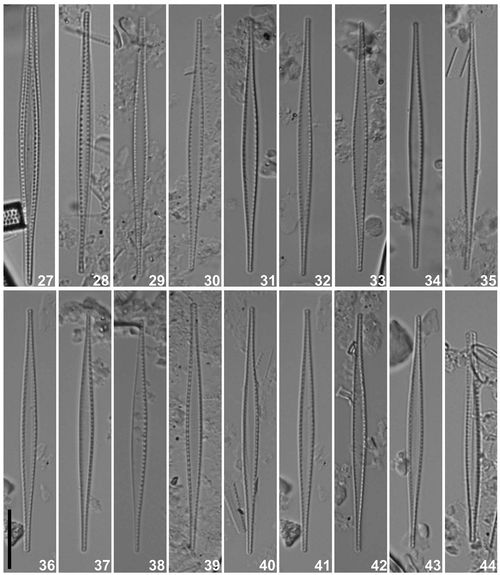
FIGURES 27–44. Nitzschia williamsii sp. nov. LM. Valves showing the size diminution series. Fig. 33 = holotype. Scale bar = 10
µm. (Specimens from holotype slide CESH-5-1881)
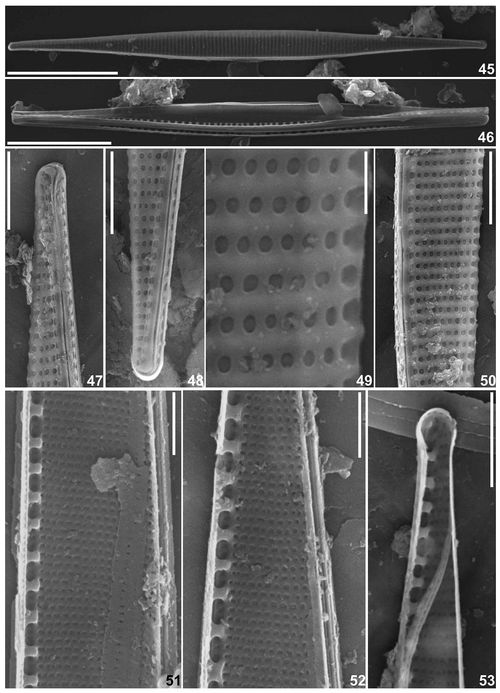
FIGURES 45–53. SEM micrographs of Nitzschia williamsii sp. nov. Fig. 45. SEM of external view of the entire valve. Fig. 46. SEM
of internal view of the entire valve. Figs 47, 48. SEM of external view of the valve apex showing terminal raphe fissures form a small
hook along each apex mantle. Figs 49, 50. SEM external view of uniseriate striae with areolae recessed between elevated ridges. Fig.
51. SEM of internal view of valve centre showing the uniseriate striae. Fig. 52. SEM of internal view of the valve showing the round
to rectangular fibulae and its spacing. Fig. 53. SEM of internal view of the valve apex showing the internal terminal nodule. Scale bars
in Figs 45, 46 = 10 µm; Figs 47, 48, 50, 53 = 2 µm; Fig. 49 = 0.5 µm; Figs 51, 52 = 1 µm. (Specimens from sample CANA 85056)
TABLE 2. Comparison of characters for selected members of linear-lanceolate to aciculoid taxa within the subgenus Lanceolatae
species of Nitzschia to N. williamsii sp. nov. (CA = central area, N-CA = no central area)

|